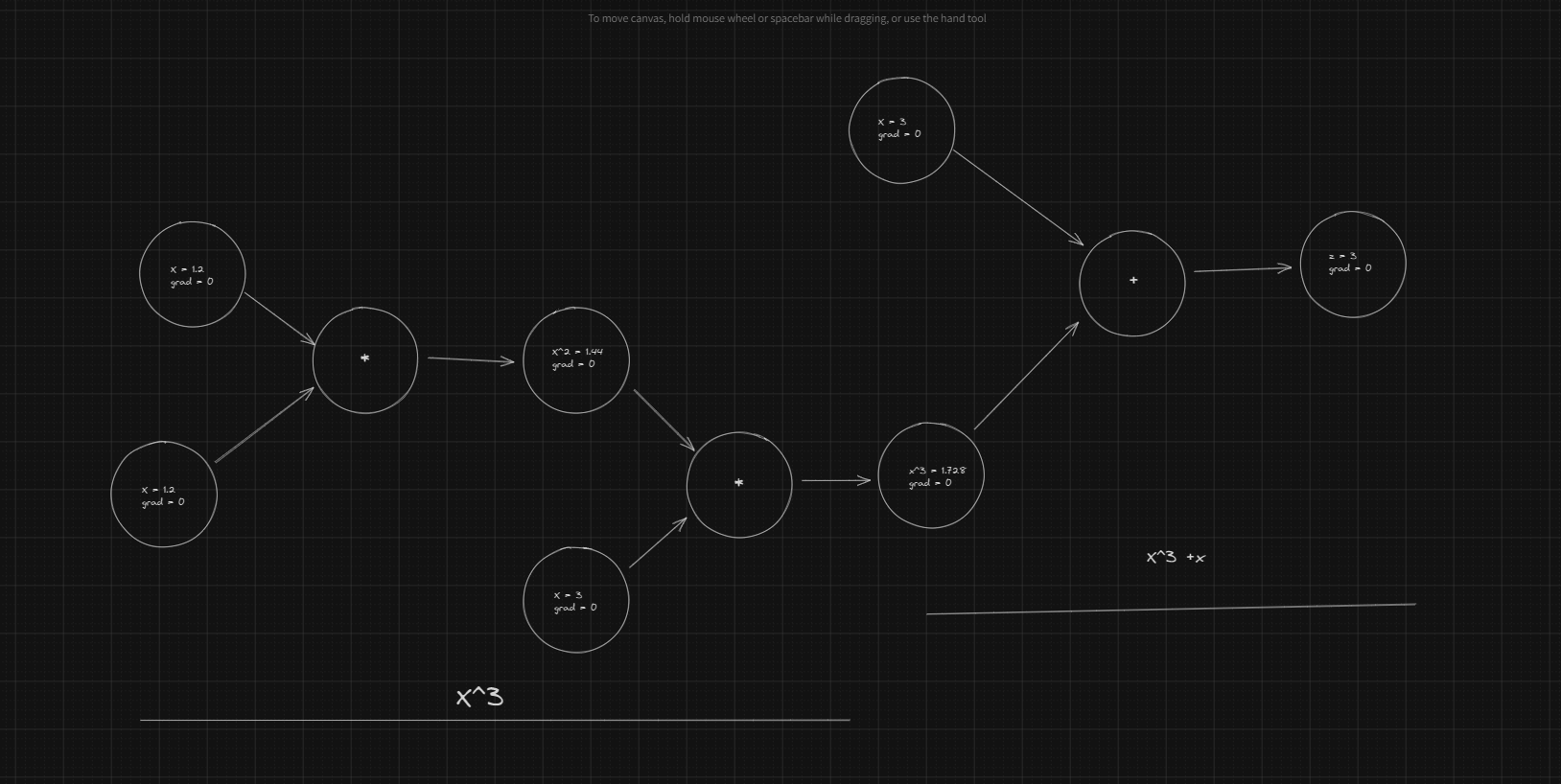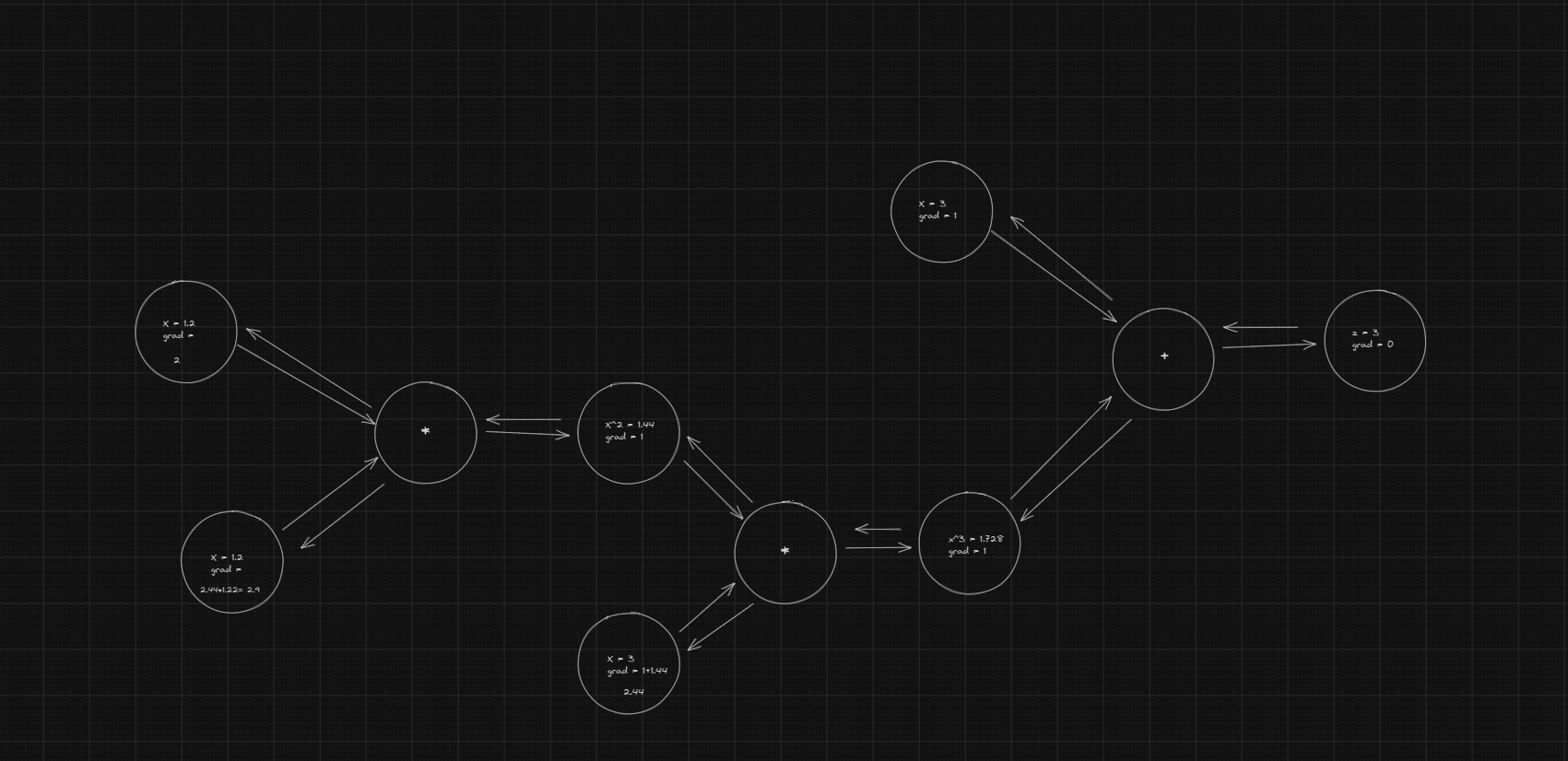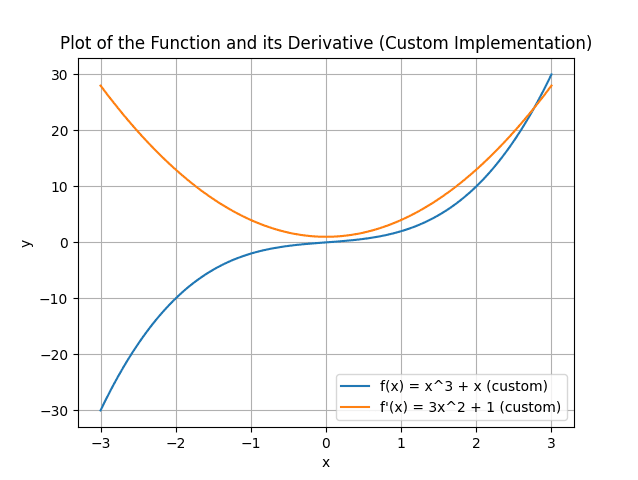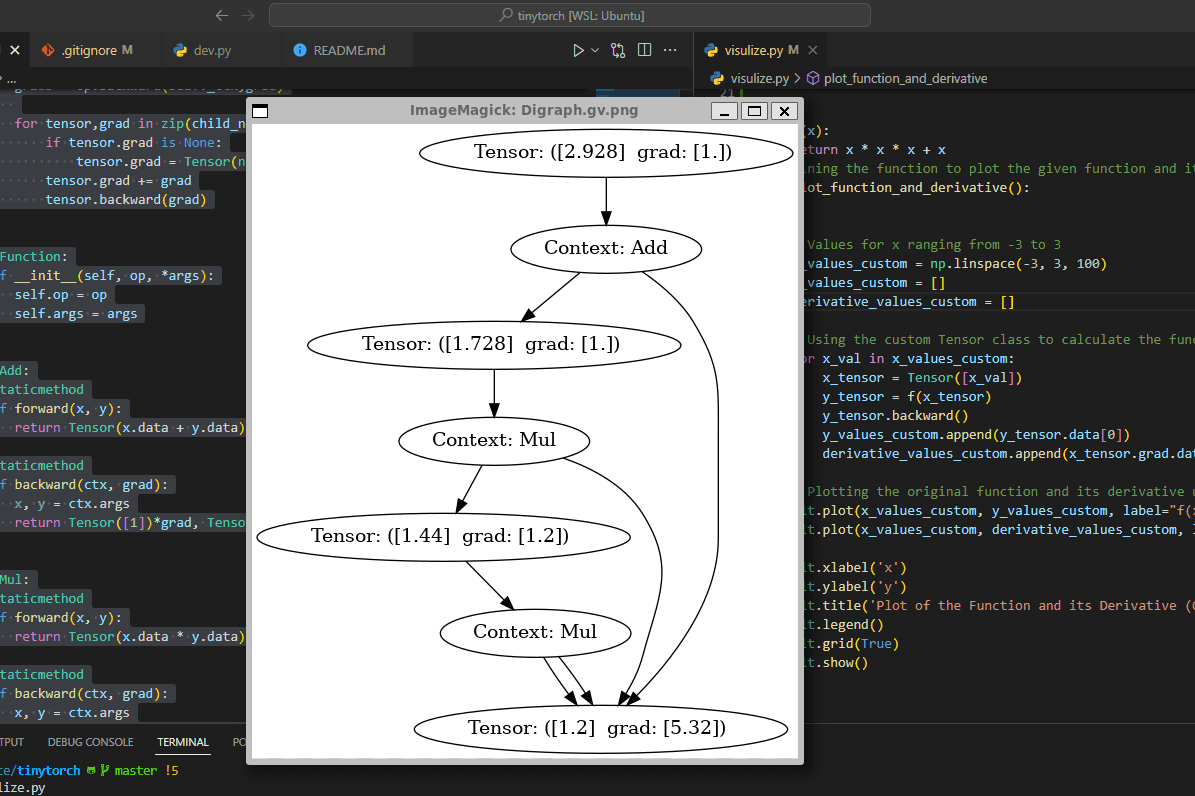- Published on
Building autograd engine (tinytorch) 02
- Authors

- Name
- Joey00072
- @shxf0072
part 2/n
Let's Write Blackward pass
backward pass is easy barely an inconvenience. steps:
- derivative of anyting with it self is 1
- backward pass with
- op.backward we will get 2 tensors grad
- set grad to each node
def backward(self,grad=None):
if grad is None:
grad = Tensor([1.])
self.grad = grad
op = self._ctx.op
child_nodes = self._ctx.args
grads = op.backward(self._ctx,grad)
for tensor,grad in zip(child_nodes,grads):
tensor.grad = grad
we take grad as input defalut None, we will set it to 1 is we get value of grad None. than to op.backward that gives us 2 grads. assiagn each grad to child node nodes.
Let's test it
if __name__ == "__main__":
x = Tensor([8])
y = Tensor([5])
print("Add")
z = x + y
print(z)
z.backward()
print(f"x: {x} , grad {x.grad}")
print(f"y: {y} , grad {y.grad}")
print("="*100)
print("Mul")
z = x * y
print(z)
z.backward()
print(f"x: {x} , grad {x.grad}")
print(f"y: {y} , grad {y.grad}")
print("="*100)
and output should be something like this
~/workspace/tinytorch master
❯ /home/joey/miniforge3/bin/python /home/joey/workspace/tinytorch/tinytorch.py
Add
tensor([13])
x: tensor([8]) , grad tensor([1])
y: tensor([5]) , grad tensor([1])
=======================================================
tensor([40])
x: tensor([8]) , grad tensor([5])
y: tensor([5]) , grad tensor([8])
=======================================================
Commit c5a9452c0ef0e23363d84cd44cacd362d53f398b
Connecting Graph
Now we can get grad for +,* lets extend it to composite function supoose you have function you can break it own as 3 step
This in graph will look like this


So now we need to pass gradient to previous computaion graph lets modify backward mathoed
def backward(self,grad=None):
if self._ctx is None:
return
if grad is None:
grad = Tensor([1.])
self.grad = grad
op = self._ctx.op
child_nodes = self._ctx.args
grads = op.backward(self._ctx,grad)
for tensor,grad in zip(child_nodes,grads):
if tensor.grad is None:
tensor.grad = Tensor(np.zeros_like(self.data))
tensor.grad += grad
tensor.backward(grad)
here we are early return if self._ctx is None that mean we reached at the end of out graph. and now insted of setting grad we init it with zeros (in shape of original). and then we to add grad to it. tensor.grad += grad here we accumulate gradients.
we also need to change Add and Mul method to use upsteam gradient
class Add:
@staticmethod
def forward(x, y):
return Tensor(x.data + y.data)
@staticmethod
def backward(ctx, grad):
x, y = ctx.args
return Tensor([1])*grad, Tensor([1]) *grad
class Mul:
@staticmethod
def forward(x, y):
return Tensor(x.data * y.data) # z = x*y
@staticmethod
def backward(ctx, grad):
x, y = ctx.args
return Tensor(y.data)*grad, Tensor(x.data)*grad # dz/dx, dz/dy
now we multiplay current grad with upstream grad so they will change accouding to incoming grads
Lets Test it
if __name__ == "__main__":
def f(x):
return x*x*x + x
x = Tensor([1.2])
z = f(x)
z.backward()
print(f"X: {x} grad: {x.grad}")
❯ python tinytorch.py
X: tensor([1.2]) grad: tensor([5.32])
Lets visualize this. now we can calculate gradient at each piont and to backward pass on it. and plot this

in our visulize.py add this code. here we are calculationg grad at each point and ploting it
import graphviz
import matplotlib.pyplot as plt
from tinytorch import *
G = graphviz.Digraph(format="png")
G.clear()
def visit_nodes(G: graphviz.Digraph, node: Tensor):
uid = str(id(node))
G.node(uid, f"Tensor: ({str(node.data) } { 'grad: '+str(node.grad.data) if node.grad is not None else ''}) ")
if node._ctx:
ctx_uid = str(id(node._ctx))
G.node(ctx_uid, f"Context: {str(node._ctx.op.__name__)}")
G.edge(uid, ctx_uid)
for child in node._ctx.args:
G.edge(ctx_uid, str(id(child)))
visit_nodes(G, child)
def f(x):
return x * x * x + x
# Defining the function to plot the given function and its derivative using the custom Tensor class
def plot_function_and_derivative():
# Values for x ranging from -3 to 3
x_values_custom = np.linspace(-3, 3, 100)
y_values_custom = []
derivative_values_custom = []
# Using the custom Tensor class to calculate the function and its derivative for each x value
for x_val in x_values_custom:
x_tensor = Tensor([x_val])
y_tensor = f(x_tensor)
y_tensor.backward()
y_values_custom.append(y_tensor.data[0])
derivative_values_custom.append(x_tensor.grad.data[0])
# Plotting the original function and its derivative using the custom implementation
plt.plot(x_values_custom, y_values_custom, label="f(x) = x^3 + x (custom)")
plt.plot(x_values_custom, derivative_values_custom, label="f'(x) = 3x^2 + 1 (custom)")
plt.xlabel('x')
plt.ylabel('y')
plt.title('Plot of the Function and its Derivative (Custom Implementation)')
plt.legend()
plt.grid(True)
plt.show()
if __name__ == "__main__":
plot_function_and_derivative()
x = Tensor([1.2])
z = f(x)
z.backward()
visit_nodes(G, z)
G.render(directory="vis", view=True)
print(f"Z:{x} grad:{x.grad}")
and for referance tinytorch.py
import numpy as np
class Tensor:
def __init__(self, data):
self.data = data if isinstance(data, np.ndarray) else np.array(data)
self.grad = None
self._ctx = None
def __add__(self, other):
fn = Function(Add, self, other)
result = Add.forward(self, other)
result._ctx = fn
return result
def __mul__(self, other):
fn = Function(Mul, self, other)
result = Mul.forward(self, other)
result._ctx = fn
return result
def __repr__(self):
return f"tensor({self.data})"
def backward(self,grad=None):
if self._ctx is None:
return
if grad is None:
grad = Tensor([1.])
self.grad = grad
op = self._ctx.op
child_nodes = self._ctx.args
grads = op.backward(self._ctx,grad)
for tensor,grad in zip(child_nodes,grads):
if tensor.grad is None:
tensor.grad = Tensor(np.zeros_like(self.data))
tensor.grad += grad
tensor.backward(grad)
class Function:
def __init__(self, op, *args):
self.op = op
self.args = args
class Add:
@staticmethod
def forward(x, y):
return Tensor(x.data + y.data)
@staticmethod
def backward(ctx, grad):
x, y = ctx.args
return Tensor([1])*grad, Tensor([1]) *grad
class Mul:
@staticmethod
def forward(x, y):
return Tensor(x.data * y.data) # z = x*y
@staticmethod
def backward(ctx, grad):
x, y = ctx.args
return Tensor(y.data)*grad, Tensor(x.data)*grad # dz/dx, dz/dy
if __name__ == "__main__":
def f(x):
return x*x*x + x
x = Tensor([1.2])
z = f(x)
z.backward()
print(f"X: {x} grad: {x.grad}")
graphvis computation graph

commit f1fb4c1b7b0ea51d270651337c600a2a3cabe267